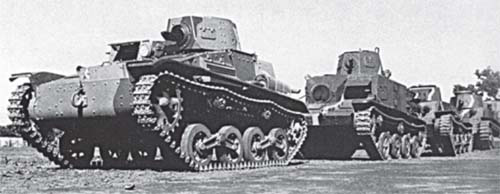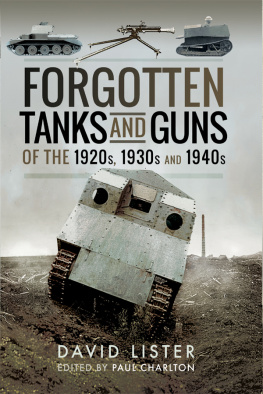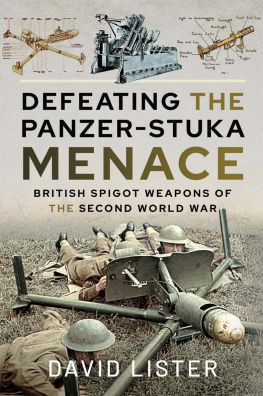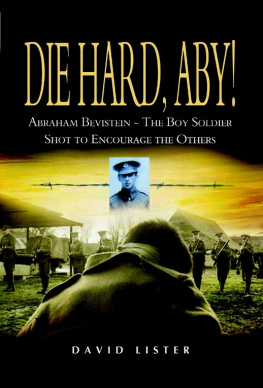David Lister - Forgotten Tanks and Guns of the 1920s, 1930s and 1940s
Here you can read online David Lister - Forgotten Tanks and Guns of the 1920s, 1930s and 1940s full text of the book (entire story) in english for free. Download pdf and epub, get meaning, cover and reviews about this ebook. year: 2018, publisher: Pen and Sword, genre: Non-fiction. Description of the work, (preface) as well as reviews are available. Best literature library LitArk.com created for fans of good reading and offers a wide selection of genres:
Romance novel
Science fiction
Adventure
Detective
Science
History
Home and family
Prose
Art
Politics
Computer
Non-fiction
Religion
Business
Children
Humor
Choose a favorite category and find really read worthwhile books. Enjoy immersion in the world of imagination, feel the emotions of the characters or learn something new for yourself, make an fascinating discovery.
- Book:Forgotten Tanks and Guns of the 1920s, 1930s and 1940s
- Author:
- Publisher:Pen and Sword
- Genre:
- Year:2018
- Rating:5 / 5
- Favourites:Add to favourites
- Your mark:
- 100
- 1
- 2
- 3
- 4
- 5
Forgotten Tanks and Guns of the 1920s, 1930s and 1940s: summary, description and annotation
We offer to read an annotation, description, summary or preface (depends on what the author of the book "Forgotten Tanks and Guns of the 1920s, 1930s and 1940s" wrote himself). If you haven't found the necessary information about the book — write in the comments, we will try to find it.
David Lister: author's other books
Who wrote Forgotten Tanks and Guns of the 1920s, 1930s and 1940s? Find out the surname, the name of the author of the book and a list of all author's works by series.
Forgotten Tanks and Guns of the 1920s, 1930s and 1940s — read online for free the complete book (whole text) full work
Below is the text of the book, divided by pages. System saving the place of the last page read, allows you to conveniently read the book "Forgotten Tanks and Guns of the 1920s, 1930s and 1940s" online for free, without having to search again every time where you left off. Put a bookmark, and you can go to the page where you finished reading at any time.
Font size:
Interval:
Bookmark:

OF THE 1920s, 1930s AND 1940s
DAVID LISTER

First published in Great Britain in 2018 by
Pen & Sword Military
An imprint of
Pen & Sword Books Ltd
Yorkshire Philadelphia
Copyright David Lister, 2018
ISBN 978 1 52671 453 4
eISBN: 978 1 52671 455 8
Mobi ISBN: 978 1 52671 454 1
The right of David Lister to be identified as Author of this work has been asserted by him in accordance with the Copyright, Designs and Patents Act 1988.
A CIP catalogue entry for this book is available from the British Library.
All rights reserved. No part of this book may be reproduced or transmitted in any form or by any means, electronic or mechanical including photocopying, recording or by any information storage and retrieval system, without permission from the Publisher in writing.
Pen & Sword Books Ltd includes the Imprints of Pen & Sword Aviation, Pen & Sword Family History, Pen & Sword Maritime, Pen & Sword Military, Wharncliffe Local History, Pen & Sword Select, Pen & Sword Military Classics, Leo Cooper, The Praetorian Press, Remember When, Seaforth Publishing and Frontline Publishing.
For a complete list of Pen & Sword titles please contact
PEN & SWORD BOOKS LIMITED
47 Church Street, Barnsley, South Yorkshire, S70 2AS, England
E-mail:
Website: www.pen-and-sword.co.uk
Or
PEN AND SWORD BOOKS
1950 Lawrence Rd, Havertown, PA 19083, USA
E-mail:
Website: www.penandswordbooks.com
Since 2013 I have been delving into archives as part of my consultancy work on military history. This has led to my viewing files that have not been viewed by historians before whether they had been misfiled, or just not been specific enough for other historians to request. There have been many odd finds: some if not all have not been enough for more than a few paragraphs about them and the files contents.
A few years ago one of my friends pointed out I had a lot of projects that history had forgotten and suggested that I compile them into a book. This idea launched the project that has finally resulted in this book. It has taken some time to compile all the plans, drawings and files, as well as writing the actual document but I hope you will enjoy it.
So please let me show you a collection of invention, genius and optimistic thought that results in a selection of historys lost tanks and guns.
David Lister
For more history, including weekly articles:
www.historylisty.com
www.facebook.com/historylisty
Seon Eun Ae: for her help with the Japanese tanks.
www.sensha-manual.blogspot.co.uk
Ed Francis: proof-reading and sharing information.
Paul Charlton: editing
Andrew Hills: for being a tank-obsessed friend I could discuss my findings with, digging through patents and for sharing information.
Teodor S. Angheluta and Andrei Kirushkin: for their artwork.
The Members of The Shop channel: for random help and assistance during the writing of this book.
The plans in Lurking in the Jungle are more basic than ones later in the book and are designed to show the basic arrangements of the tanks. This is in part due to the condition of the original documents which were printed on a much glossier paper than we might find normal today. As a result, much of the image has been degraded over time. Equally, to keep the plans simple, many of the fixtures and the details have been omitted.
The work of an intelligence officer is not easy because of a mixture of enemy disinformation, the varying quality of material supplied to you and your own preconceived notions and prejudices. Take, for example, the subject of Japanese heavy tanks. The common perception today is that the Japanese heavy tank projects never progressed past a handful of experimental designs and one rather hopeful super-heavy project during the Second World War. Beyond that, it is commonly thought that the Japanese did not field any heavy tanks.
During the Second World War nearly every nation had some form of heavy tank, and it was known to the British, from reliable sources, that the Japanese had been experimenting on the class. It was expected that the Japanese would at some point start to use them, and British intelligence tried to keep a track on Japanese tank development.
Among the sources that fed information back to the UK was the British military attach in Tokyo. One such report was about a Japanese tank exhibition between 10 and 16 February 1939. Held at the Yasukuni Shrine, the purpose was to allow the public to view tanks and armoured vehicles, some captured in China, others domestically built. The collection was drawn up in two rows on either side of the shrine and enclosed by barriers allowing people to get no closer than about six feet. Photography was banned and the area swamped with Kempeitai officers to make sure this was obeyed. The military attach, Major T.G. Wards, however, visited the exhibition and filed a report on what he saw. Major Wards noted that, as a foreign observer, his actions were closely monitored and he was unable to give each tank more than a passing glance due to the presence of the Kempeitai.

A line of tanks at a Japanese display, perhaps even the one at Yasukuni Shrine. The tank nearest the camera is a Type 94 tankette; next is a Type 92 heavy armoured car. The rearmost tank is a Type 89 of some variant, but in between it and the Type 92 is an unidentified tank. From the limited view of this picture it seems to match the Ishi 2598 (see ).
The first exhibit was captured material, such as Chinese armoured cars, which were civilian trucks which had been armoured. Something referred to as an Ansard light tank, which weighed three tons and had a crew of two and two machine guns, was possibly an Ansaldo CV.3, an Italian tankette.
Next came the Japanese tanks, starting with a heavy tank. The heavy tank Wards saw may have been the Experimental II with a main gun in both the turret and the hull, and a mini-turret at the rear housing a machine gun. One of the other exhibits was a Type 89 I-Go that had seen action in China. It had been taken under heavy small-arms fire and was claimed to have been hit about a thousand times.
After the war started sources became harder to come by. Intelligence officers had to make do with incomplete snippets of information, or information from prisoner of war interrogations. Some such interrogations seem to have muddied the waters, e.g. from these it appears that the Type 97 Chi-Ha was often mistaken for a heavy tank.
One prisoner of war was a lieutenant in the 1st Independent Mixed Regiment on Saipan, captured in July 1944. He stated that the Type 97 Chi-Ha had 15mm of armour and a twelve-cylinder diesel engine; his unit had trained on them in August 1941. He also claimed that all tanks had radios, air conditioning and twin 47mm guns, with one mounted in the standard turret and another in the hull and that they could fit thirty ammunition boxes in the tank, each box being 2-feet long, 1-foot tall and 1.5-feet wide. Finally, and most bizarrely, he claimed that, as well as one drive wheel at the front, it had two smaller drive wheels at the back, both 14 inches across. The intelligence report indicated that this might signify an earlier model suspension. The prisoner of war also gave a rundown of crew numbers: three men for this particular medium tank, two for a light tank and an unknown number for a heavy tank.
Font size:
Interval:
Bookmark:
Similar books «Forgotten Tanks and Guns of the 1920s, 1930s and 1940s»
Look at similar books to Forgotten Tanks and Guns of the 1920s, 1930s and 1940s. We have selected literature similar in name and meaning in the hope of providing readers with more options to find new, interesting, not yet read works.
Discussion, reviews of the book Forgotten Tanks and Guns of the 1920s, 1930s and 1940s and just readers' own opinions. Leave your comments, write what you think about the work, its meaning or the main characters. Specify what exactly you liked and what you didn't like, and why you think so.











